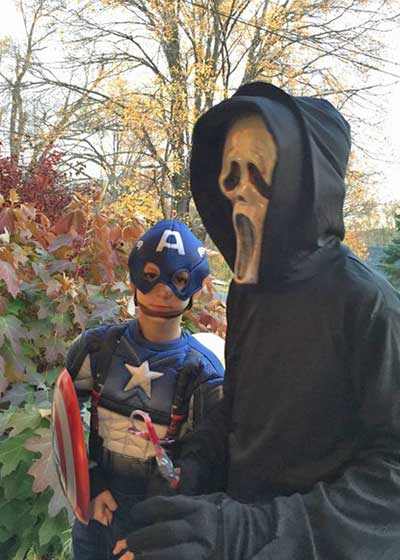Main Street Business

Halloween Phenomenon
For October’s history issue we researched the long history of October 31 celebrations and the increasing commercial importance of this holiday. Halloween is not only a night of fantasy – you can dress up as anyone or anything regardless of age, nationality, politics, or gender – it is a growing business opportunity. Internationally, Halloween is seen in some countries as American cultural imperialism with Disney theme parks in Shanghai, Hong Kong, Paris, and Tokyo promoting special Halloween parades, food, and merchandise.
The oldest holiday?
From its mistiest past Halloween, like most holiday celebrations, involved feasting and partying. Cultural historians trace the beginning of Halloween to the feast of Samhain celebrated in Celtic Ireland, Scotland, England, and Brittany. Marking the end of harvest, November 1 was the beginning of the Celtic year. The Celts believed that on October 31 the ghosts of the dead returned to earth, and to frighten them away they lit bonfires and dressed in frightening costumes.
With the arrival of the Romans on the British Isles in 55 BC, Celtic Druid priests were gradually eliminated, and this ancient holiday became merged with Pagan ideas about exorcising the dead. With the advent of the Christian era, traditions were melded again. In the eighth century, Pope Gregory made November 1 All Saints Day, and All Hallows Eve on October 31 became Halloween celebrated with bonfires, parades, and costumed angels, devils, and saints. The origins of trick or treating may have begun in England when poor citizens would beg for food and be given “soul cakes” if they promised to pray for a family’s dead relatives.
In Protestant America, the holiday was not widely celebrated until the wave of immigrants from Ireland and Scotland arrived in the middle of the 1800s. These immigrants brought the tradition of children playing tricks on Halloween. According to Lisa Morton, author of Trick or Treat, farm animals were placed on barn roofs, vegetable gardens uprooted, and gates unhinged letting livestock go free. In cities, manhole covers were removed, tires deflated, street signs turned, and fires lit. Malicious violence and looting steadily grew worse and by the Depression many cities considered banning the celebration altogether. During World War II, youngsters took pledges to support the troops and not create havoc. Gradually the holiday has evolved in most places into a community and neighborhood event with children behaving themselves and gathering bags of candy.
 Halloween economics
Halloween economics
Despite the aisles of candy at CVS, don’t believe claims that Halloween is the second biggest spending season after Christmas – there’s even misinformation about holidays. The National Retail Federation estimates that Halloween generates sales of $9 billion every year – in terms of spending, if not in fun, it’s much less than back to school, Mother’ and Father’s Day, Easter, and, of course, dwarfed by Christmas. Roughly $2.6 billion is splurged on costumes for children, adults and pets including scary contact lenses, make-up, and fake teeth. Another $2.6 billion is spent on the huge category of Halloween décor which includes the 12’ long plastic skeleton already sold out this year at Home Depot, skull drinking glasses, Styrofoam head stones, inflatable ghosts, etc. Halloween is the biggest candy holiday of the entire year – 25% of all the candy sold in a year is purchased in September and October accounting for close to $3 billion in seasonal sales. Greeting cards account for only $400 million with an estimated 21 million cards sent – way behind Mother’s Day at a 133 million greetings.
What about pumpkins?
In the Northeastern United States almost 25,000 acres are devoted to pumpkin crops. Nationally it’s estimated by the USDA that over a billion pounds of pumpkins are grown, racking up another $200 million in sales for Halloween.
Jessica Cookingham of Daisy Hill Farm in Millerton, NY, reported that, “October is one of our big months and is very important for our roadside farm stand. There are hayrides, a pumpkin catapult, a corn maze and free funny look-throughs for family photos. It’s fun to watch the excitement of the kids picking out pumpkins and watching them grow up as they return year after year. We grow and harvest all of our own pumpkins.”
These activities extend the farm stand’s business until October 31 when it’s time to close before opening again to sell Christmas trees after Thanksgiving.
Boo!
Immersive horror haunted house attractions with professional make-up artists, actors, animatronics, and Hollywood quality sets can gross as much as $2 to $3 million dollars in a fall season with individual ticket prices reaching $75. There are even trade associations like America Haunts and the Haunted House Association, which estimate that these venues contribute $300 million in Halloween spending in September and October.
Locally The Headless Horseman Hayrides and Haunted House has been voted as the number one haunted attraction in the nation. Located on Route 9W south of Kingston, NY, the ticket sales for this year’s event starting on September 25 are on a par with 2019. People come from all over the country to be scared and some attend three or four times every year, according to the owners, Michael and Nancy Jubie. Their scary enterprise has 12 year-round employees with as many as 350 part-time seasonal workers – scaring people is labor intensive.
Halloween 2021
What will this year’s Halloween bring? Industry forecasters are predicting a blow-out Halloween with high vaccination rates and a pent-up urge to celebrate and gather. Scott Smiledge, the owner of Gothica, believes that, “With Halloween falling on a Sunday this year, we are expecting to see parties and events in record numbers. We are already seeing huge demand in people preparing for the season. In 25 years, I haven’t seen anything like this before. People are ready to get out and party and be reunited with their friends and family.”
No one knows how the Covid virus will affect activities this year. In 2020 Halloween participation and overall spending declined with 75% of those celebrating saying that the virus had impacted their way of observing the holiday. Handing out candy will likely remain the most popular way to observe the holiday and hopefully neighborhood trick or treaters dressed as princesses, witches, and superheroes will ring our doorbells.



